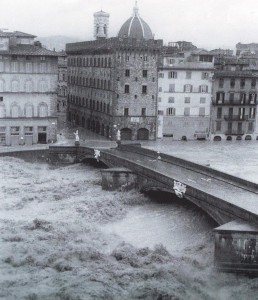
Photo by Swietlan Nicholas Krazcyna
In an effort to inject a healthy dose of genuine culture and learning into this irreverent stump of mine, I’m thrilled to have a guest post today from authors Jane Fortune and Linda Falcone from the Advancing Women Artists Foundation, talking about their book on the 1966 flood in Florence.
Furthermore, I’d like to add that…you know what? I’m not going to say anymore. I can only diminish the value of their erudite and emotional article. I will, however, give them my sincere “Grazie!” Enjoy!
###
On November 4, 1966, the “Silvery River”, as a folk song calls the Arno, became black with despair. Florentines awoke that morning to find a flood roaring beneath their windowsills. Those on the lower floors immediately appealed to their luckier top-floor neighbors as 400,000 tons of mud and rubble pushed them to abandon their homes. Mud, floating furniture, animal carcasses, heating oil from exploded boilers—Florence was transformed into a mire-filled marshland. The words of Dante’s Purgatory turned suddenly prophetic: the river had become a “damned accursed ditch”, an open public grave—albeit, more for artwork than for people.
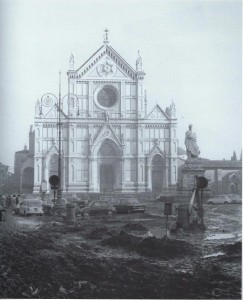
Even today, nearly fifty years later, Florence’s art casualties have not yet been counted with absolute certainty. During the deluge, five panels of Ghiberti’s Doors of Paradise were ripped from the Duomo’s Baptistery and Donatello’s Penitent Magdalene—stained to the knee with oil and ooze—was swept outside the venue, in merciless disgrace. Yet, she was not alone in her plight. An estimated 14,000 works of art were harmed, including Cimabue’s wooden Crucifix which quickly became a world-wide symbol of Florence’s plight. In its home—the Franciscan Basilica of Santa Croce—water levels had reached over 20 feet and two months would pass until the sludge could be removed from its interior. (The entrance of Santa Croce’s Pazzi Chapel is an interesting spot where visitors can view several ‘flood markers’, or marble plaques indicating water levels during four of the over fifty floods that Florence has experienced since the mid-thirteenth century.)
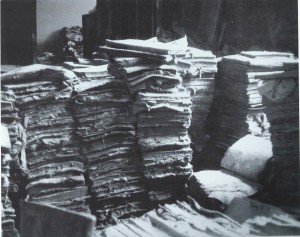
Photo by Swietlan Nicholas Krazcyna
As Florentine art professionals rushed to contain the damage, a ‘statue hospital’ was set up in Palazzo Davanzati, while the city’s first panel paintings were rushed to dry amid the orange tree’s of the Boboli Garden’s Limonia—an eighteenth-century hothouse for growing the Medici dynasty’s citrus fruits. The temperature-control strategy employed at that makeshift base would, months later, prove detrimental—the first batch of 250 waterlogged paintings literally “shrank” before the eyes of horrified experts. Meanwhile, at the Central National Library skilled restorers were harder to come by—yet a monumental rescue effort was immediately put into place as thousands of students from around the world flocked to the city in an attempt to salvage the three thousand tons of books damaged there. Almost immediately christened ‘Angeli del Fango’ or ‘Mud Angels’, these young people formed bucket brigades throughout the city to remove the mud and rubble. Florence’s tireless mayor Piero Bargellini, whose daughter Antonina we interviewed for our book When the World Answered: Florence, Women Artists and the 1966 Flood, remembers her father’s reaction to the onslaught of eager young volunteers—many of whom were not yet eighteen: “Where am I going to put all these children? my father wondered. He felt like he was responsible for them. In fact, in those days, all of Florence was our family.”
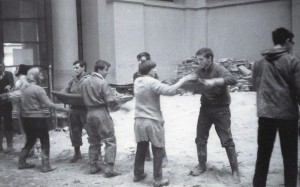
Photo by Swietlan Nicholas Krazcyna
Indeed, the Bargellini home at the epicenter of the disaster, kitty-corner to Santa Croce, became a base for providing aid to flood victims. (The flood had ripped off the building’s main door, so his was “an open door to Florentines” quite literally!) With regards to hosting “the children”, Bargellini struck a deal with the Italian Railways and had lodgings set up for a large portion of these 3,000 young guests in sleeper cars. The wise philosopher-mayor understood the situation immediately: there would be no stopping the flood of international support that Florence’s predicament inspired. Though the Italian president was slow to send support, volunteers arrived and funds poured in from all over the world. Florence, the center of Humanism—the center of humanity even—had been wounded, and art lovers everywhere were intent on helping it heal.
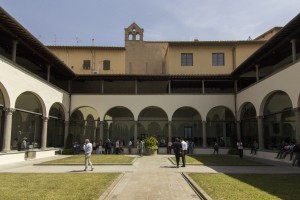
Photo by Francesco Cacchiani
Within this struggle to save the city’s artistic heritage one art historian, a Pisan professor named Carlo Ludovico Ragghianti, had a very different view of how to “save Florence”. The city, Ragghianti thought, needed to concentrate at least part of its efforts on “securing its future” in both the art industry and tourism. Florence needed to rise up from its ashes like the mythological phoenix and quickly re-assert itself as a leader on the world’s art scene. Could contemporary artists from all over the globe be called upon to donate their works to the city that had lost so much? Could they ban together to create an “Uffizi of Modern Art” whose creation would prove Florence’s cultural revival and catapult the city into the twentieth-century? Hundreds of artists, including dozens of women, responded to Ragghianti’s appeal known as ‘Artisti per Firenze’ or “Artists for Florence” on the promise that their works would one day be exhibited in the city’s first public venue for contemporary art. Though Ragghianti worked toward his dream until his death in 1980, the forward-thinking scholar did not see it reach fulfillment. Only recently, in June 2014, the city of Florence finally inaugurated its Museo Novecento in Piazza Santa Maria Novella—in a newly-restored 20-room museum that was originally built as a hospital in the 1300s.
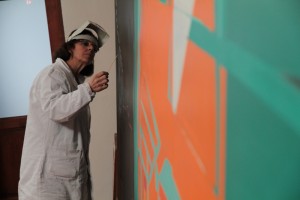
Photo by Francesco Cacchiani
Visitors can see works by “the greats” of Italian twentieth-century painting and sculpture including Giorgio de Chirico, Giorgio Morandi and Renato Guttuso, as well as several works by international women artists, such as Pop artist Titina Maselli, figurative sculptor Antonietta Raphael Mafai and Abstract master Carla Accardi. Works by these last three artists were recently at the center of a conservation project sponsored by the Advancing Women Artists Foundation, a not-for-profit organization dedicated to discovering, restoring and exhibiting art by women languishing in the Florence museums and storehouses.
Since the museum’s inauguration, the AWA Foundation has agreed to restore 27 more works by women gifted as a result of the “Artists for Florence” appeal. The restoration will be completed in time for an exhibition commemorating the flood’s fiftieth anniversary in 2016, scheduled at the Museo Novecento. These newly exhibited works represent the flood’s continued legacy—the good that came out of what film director Franco Zeffirelli called “Days of destruction.” It is time for Florence and the world to see this art beneath the museum spotlight and remember the generosity of those who came forward to share in the city’s timeless vocation: to be a center of art for generations to come.
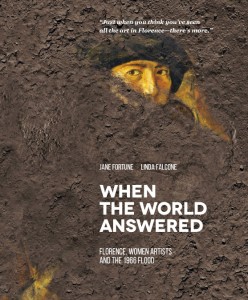
For more information about the flood and the women artists who donated their works to the city, check out “When the World Answered: Florence, Women Artists and the 1966 Flood.”
The book will soon become the backbone of a documentary produced by PBS for American television! Scheduled to air Stateside in November 2015, the program will be a follow-up to the PBS special inspired by our previous book Invisible Women: Forgotten Artists of Florence, which won an Emmy Award in 2013.
To learn more about the Advancing Women Artists Foundation and its work in Florence, visit our Facebook Page or our website, Advancing Women Artists.
Author Bios
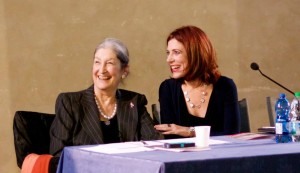
Photo by Leo Cardini
Dr. Jane Fortune is founder and chair of the Advancing Women Artists Foundation and cultural editor of The Florentine, Tuscany’s English-language newspaper. Her books include To Florence, Con Amore: 90 Ways to Love the City and Invisible Women: Forgotten Artists of Florence. With Linda Falcone, she co-authored Art by Women in Florence: A Guide through Five Hundred Years and When the World Answered: Florence, Women Artists and the 1966. In the United States, she serves on the Board of Trustees at the Indianapolis Museum of Art and on the National Advisory Board at both the National Museum of Women in the Arts and the Indiana University Art Museum. In Florence, she is on the Board of Trustees of the Medici Archive Project, where she has endowed a pilot program dedicated to researching women artists in the age of the Medici.
Linda Falcone is director of the Advancing Women Artists Foundation in Italy. She is co-author with Jane Fortune of Art by Women in Florence: A Guide through Five Hundred Years. She is also author of two nonfiction books, Italians Dance and I’m a Wallflower and If They Are Roses: The Italian Way with Words, as well as the novel Moving Days. Editor of Santa Croce in Pink: Untold Stories of Women and their Monuments and Chaplin and Costa: Rediscovering Expat Women Painters in Tuscany, she has also co-authored several documentaries on women artists including Félicie de Fauveau: A French Sculptor in Florence during the Grand Tour. She is also a lecturer and adjunct professor of Italian Culture and Travel Writing for various American university programs abroad.

When I was studying at Il Bisonte in the San Niccolo area, I met the founder Maria Luigia Guaita (sadly now deceased). I heard her amazing story of the flood and saw the little door where her nephew rescued her from her flooding bedroom. Hopefully this never happens again! Ciao, Cristina
Grazie, Cristina! Last time I was in Florence (May 2014), I went into a little shop where they make gold jewelry by hand. On the wall, there was a line painted that just said, “1966.” I couldn’t believe how HIGH it was!!
Rick, so glad to know that you have contact with Jane Fortune! I have met Jane a number of times in michigan where she has a wonderful restaurant, Bella Fortuna. During the summer months, she hosts very interesting events focusing on Italian art, culture and, of course food and wine. I have considered joining her small travel group to Florence on several occasions. She is a very talented and involved individual..
If anyone is interested in the small group tour that Jane (AWA) provides, here is the link, it looks awesome!!!! http://www.sojourntoflorence.com/
Thanks for sharing, Georgette!!!
Absolutely! A worthy cause..
Great post Rick, I really appreciate you spreading the word about this tragic event and the Advancing Women Artists Foundation which are really doing some remarkable things. They deserve our support if we have any hope of seeing these talented women artists have the recognition they deserve.
Thanks Georgette. I was happy to share the post on the strength of the writing alone. But when I read about the great work they’re doing, it was a really an honor for me to help spread the word and support them in any way that I can. Ciao!!
Every time I read this story I am amazed at the level of devastation to the city of Florence and its history. But even more amazing was the global response to the plight faced by the city. This was truly mankind exhibiting unrivaled compassion. Thanks for sharing.
Is it possible for this river to flood again like this?
Yes, the river could flood again. The River Arno often threatens the city. However, precautions have been taken to mitigate potential future damage. Let’s hope we never have to see if they are effective.
Oh dear, I hope so too.
Thanks for the reply Earl. You beat me to it, and said it better than I could have.
As a HS soph back then, our Latin Club was on an extended month-long trip to Rome, Florence, Bologna & Venice. Yep – you guessed it – we arrived in Florence on Nov. 6, 1966 and were mortified about the flood. Fortunately, we had some wealthy patrons sponsoring our trip from back home who “aperto qualche porta” for us so we could see and tour the museums which, unfortunately, were sporadically shut down for most of the next month for many of the Florence visitors.
But the one thing I remember about my first (of many) visits to Florence was the cooking school which opened up its doors to us when they discovered our plight. The eight of us on the trip ended up learning how to cook Florentine dishes that we eventually ate for ourselves. In fact, one girl ended up opening up high end Italian restaurants in Hong Kong, Tel Aviv, London and a slew of other places due to the inspiration from the trip.
Per me, I ended up buying the building the cooking school was in about ten years ago.